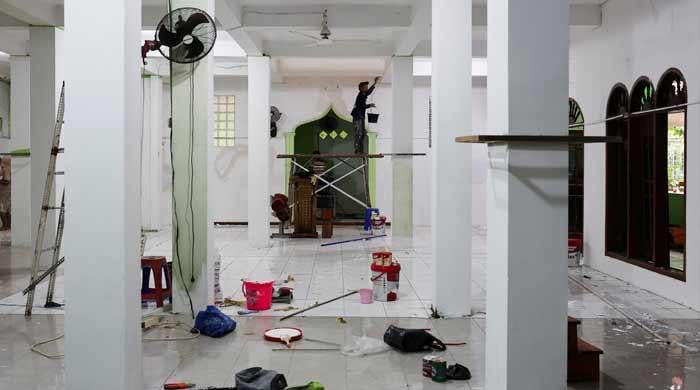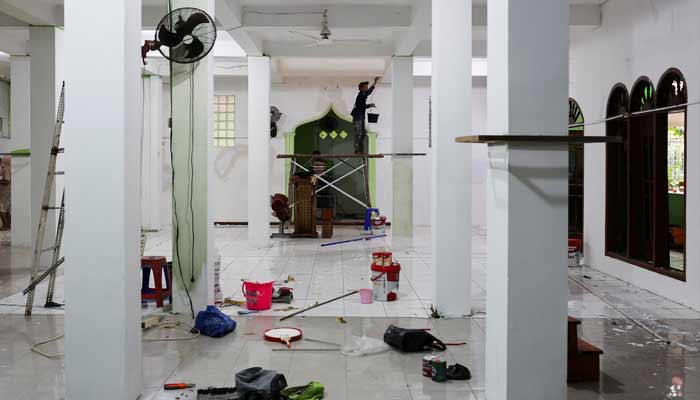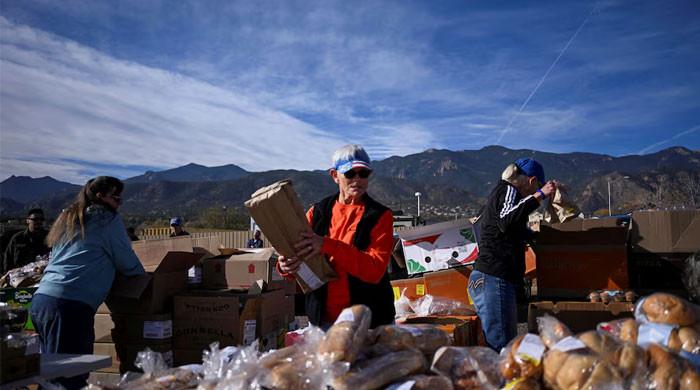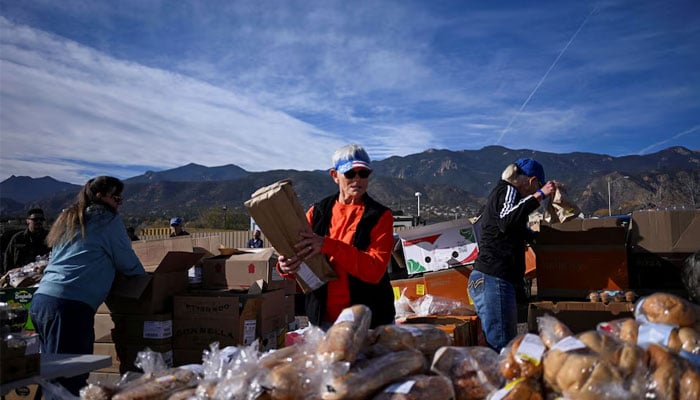Politics
Russia attacks Ukraine energy facilities, kills three people


- Zelenskiy urges more sanctions on Russia for energy attacks.
- Naftogaz reports damage to gas facilities.
- Several Ukrainian cities using generators for power and water.
Russia launched a barrage of drones and missiles in overnight attacks on Ukraine, killing at least three people and damaging large energy infrastructure facilities in three regions, Ukrainian officials said on Saturday.
President Volodymyr Zelenskiy said Russia had launched more than 450 drones and 45 missiles.
Two people were killed and 12 wounded in the city of Dnipro when a drone hit an apartment building. One person was killed in the Kharkiv region, regional officials said.
Energy facilities in the Kyiv, Poltava and Kharkiv regions were damaged, Prime Minister Yulia Svyrydenko said.
State-owned energy company Tsentrenergo said the attacks were the largest on its facilities since the start of the war in February 2022, and that it had halted operations at its plants in the Kyiv and Kharkiv regions.
“The last strike was not even a month ago and the enemy has now struck all our generating capacity at the same time. The stations are on fire!” Tsentrenergo, which generates about 8% of Ukraine’s power, said in a statement.
“Our generation is now zero.”
Zelenskiy calls for more sanctions
Zelenskiy said sanctions pressure should be intensified.
“… for every Moscow strike on energy infrastructure – aimed at harming ordinary people before winter – there must be a sanctions response targeting all Russian energy, with no exceptions,” he said on the Telegram app.
Since the start of its invasion almost four years ago, Russia has made a point of attacking the power sector as the need for heating grows. This autumn it has attacked gas facilities nine times within two months, according to the state firm Naftogaz.
Moscow’s Defence Ministry said it had launched “a massive strike with high-precision long-range air, ground and sea-based weapons” on weapon production and energy facilities in response to Kyiv’s strikes on Russia.
Russia also said its forces continued to advance in grinding battles around the towns of Pokrovsk and Kupiansk, and had captured a tiny village in eastern Ukraine.
Ukraine regularly sends drones to strike oil facilities inside Russia.
As diplomatic peace efforts have faltered, Kyiv is trying to reduce Moscow’s ability to finance its war.
The Ukrainian air force said 406 Russian drones and nine missiles had been shot down, and 26 Russian missiles and 52 drones had hit 25 sites.
Svyrydenko said the government and energy companies were working to restoredamaged electricity, water and heating provision.
In the Poltava region, two cities – Kremenchuk with a population of about 200,000 people and Horishni Plavni with 50,000 – lost most of their electricity and were using generators to provide water, city officials said.
Politics
Tehran to restrict water as Iran battles drought


Iran was laying plans on Saturday to cut off water supplies periodically to Tehran’s 10-million-strong population as it battles its worst drought in many decades.
Rainfall in the capital has this year been at its lowest level in a century, local officials say, and half of Iran’s provinces have not seen a drop fall in months.
Now, to save water, the government is planning water cuts in Tehran — and several local news outlets have already reported pipes running dry overnight in some areas.
“This will help avoid waste even though it may cause inconvenience,” Iran’s Energy Minister Abbas Ali Abadi said on state television.
In a speech broadcast on Friday, Iran’s President Masoud Pezeshkian had warned that Tehran might have to be evacuated if no rain falls before the end of the year.
But he gave no details about how such a vast operation would be conducted.
Tehran nestles on the southern slopes of the Alborz mountains and has hot dry summers usually relieved by autumn rains and winter snowfall.
Reservoirs run dry
Tehran is by far the country’s biggest city and its inhabitants use three million cubic metres of water per day, according to local media.
The main Amir Kabir dam on the Karaj river, one of five reservoirs serving the capital, is running dry and holds only 14 million cubic litres, according to Behzad Parsa, director general of the Tehran water company, cited by the official news agency IRNA.
During the same period last year, the reservoir held 86 million cubic metres, he added, but now it only has enough to maintain supplies to the Tehran region for less than two weeks.
On Saturday, state television broadcast images of several dams, serving the central city of Isfahan and Tabriz in the northwest, showing significantly lower water levels compared to previous years.
Hassan Hosseini, the deputy Iran’s second-largest city Mashhad, told IRNA agency on Thursday that night-time water cuts were being considered to address the water shortage.
And over the summer on July and August, two public holidays were declared in Tehran to save water and energy, at a time when power outages were almost daily during the intense heatwave.
Politics
Indonesia probes student after nearly 100 hurt in school blasts


- Blasts hit school mosque during Friday prayers gathering.
- Investigators examine suspect’s family, social media.
- Twenty-nine victims remain hospitalised, with two in ICU.
Indonesian authorities said on Saturday they were investigating a student over their alleged involvement in explosions that wounded nearly 100 people at a school in the capital Jakarta.
The blasts hit a school mosque in North Jakarta just as people were gathering for Friday prayers, sparking panic among worshippers.
The national police chief said investigators had gathered “several pieces of evidence” as part of their probe.
“There’s writing, and there is also evidence of powder that could potentially have caused an explosion,” Listyo Sigit Prabowo said in comments broadcast by Kompas TV.
Authorities so far have identified one suspect, a student who was wounded in the explosions, but Listyo did not rule out the involvement of others.
Investigators are also examining the suspect’s family and social media, the police chief added.
Ninety-six people were wounded in the incident, Listyo said, revising the police’s earlier casualty figure of 54.
Twenty-nine victims remain hospitalised, including at least two in intensive care, he said.
Mayndra Eka Wardhana, spokesman for the counter-terrorism police unit Densus 88, told AFP that investigators had searched the suspect’s home.
He added that they were still probing the motive behind the incident.
A witness told AFP there was confusion over what happened.
“At first we thought it came from some electronic equipment, maybe the sound system… but it turned out the explosion came from under the prayer mat,” Kinza Ghaisan Rayyan, a 17-year-old student, said on Friday.
Politics
US Supreme Court lets Trump withhold $4 billion in food aid funding for now


WASHINGTON: The US Supreme Court on Friday allowed President Donald Trump’s administration to withhold for now about $4 billion needed to fully fund a food aid programme for 42 million low-income Americans this month amid the federal government shutdown.
The court’s order, known as an administrative stay, gives a lower court additional time to consider the administration’s formal request to only partially fund the Supplemental Nutrition Assistance Programme, known as SNAP or food stamps, for November. The administration had faced a judge-ordered Friday deadline to fully fund the programme.
Justice Ketanji Brown Jackson, who issued the stay, set it to expire two days after the Boston-based 1st US Circuit Court of Appeals rules on the administration’s request to halt a judge’s order that the US Department of Agriculture promptly pay the full amount of this month’s SNAP benefits, which cost $8.5 billion to $9 billion per month.
Jackson expects lower court to act quickly
The ruling by US District Judge John McConnell in Providence, Rhode Island, on Thursday came after the administration said it would provide $4.65 billion in emergency funding to partially cover SNAP benefits for November.
Jackson, the liberal justice assigned to review emergency appeals from a group of states that include Rhode Island, said the 1st Circuit was expected to rule on the administration’s request to block McConnell’s order “with dispatch.”
US Attorney General Pam Bondi noted the Supreme Court’s decision in a post on X, which paused a court ruling she deemed “judicial activism at its worst.”
Department of Justice lawyers told the Supreme Court that McConnell’s ruling, if allowed to stand, would “sow further shutdown chaos” by prompting “a run on the bank by way of judicial fiat.”
The administration originally planned to suspend SNAP benefits altogether in November, citing a lack of funding because of the shutdown.
But McConnell last week ordered the USDA to use emergency SNAP funding to cover part of this month’s cost. In Thursday’s ruling, he ordered the USDA to make up for the shortfall with money from a separate department programme with $23.35 billion in funding, derived from tariffs, that supports child nutrition.
McConnell, an appointee of Democratic President Barack Obama, accused the Republican Trump administration of withholding SNAP benefits for “political reasons.”
His ruling was a win for a coalition of legal challengers comprising cities, unions, and nonprofits represented by the liberal legal group Democracy Forward, and prompted the administration to ask the 1st Circuit on Friday to halt the order.
The plaintiffs told the 1st Circuit that the administration showed disregard for the harm that would befall nearly one in eight Americans if McConnell’s decision were paused and SNAP recipients were denied full benefits.
“The court should deny Defendants’ motion and not allow them to further delay getting vital food assistance to individuals and families who need it now,” the lawyers wrote.
Confusion over states’ funding
The 1st Circuit on Friday denied the Trump administration’s request to administratively stay McConnell’s ruling.
It has yet to issue a ruling on the administration’s formal request to halt the judge’s order, but the 1st Circuit panel, which consisted of three judges appointed by Democratic presidents, said it would do so “as quickly as possible.”
Skye Perryman, the head of Democracy Forward, told MSNBC that the courts hearing cases over the withholding of SNAP benefits “have been very clear, that this administration not only had the legal authority to make these payments but that the administration must make these payments.”
Hours before Friday’s Supreme Court order, the USDA informed states it was working to comply with McConnell’s order by making funds available to fully fund SNAP, even as the administration moved to appeal McConnell’s ruling, causing confusion.
After receiving the USDA memo, states including New York, New Jersey and Massachusetts said they had directed state agencies to issue SNAP benefits in full for November.
“President Trump should never have put the American people in this position,” Massachusetts Governor Maura Healey, a Democrat, said in a statement.
SNAP benefits lapsed at the start of the month for the first time in the programme’s 60-year history. Recipients have turned to already-strained food pantries and made sacrifices like forgoing medications to stretch tight budgets.
SNAP benefits are paid monthly to eligible Americans whose income is less than 130% of the federal poverty line. The maximum monthly benefit for the 2026 fiscal year is $298 for a one-person household and $546 for a two-person household.
-

 Tech1 week ago
Tech1 week agoGiant, Spooky Animatronics Are 75 Percent Off at the Home Depot
-

 Business1 week ago
Business1 week agoPrinces Group valued at £1.16bn as food firm launches London float
-
Sports1 week ago
Ravens are back in the hunt after two straight wins and Lamar Jackson’s return
-

 Tech1 week ago
Tech1 week agoKeep Tabs on Your Pets and Kids With the Best Indoor Security Cameras
-

 Fashion1 week ago
Fashion1 week agoUS Senate passes legislation challenging Trump’s tariffs on Canada
-

 Sports1 week ago
Sports1 week agoTudor’s Juve exit means McKennie must prove himself all over again
-

 Tech1 week ago
Tech1 week agoDisney content has gone dark on YouTube TV. Here’s what customers should know
-

 Tech1 week ago
Tech1 week agoNew diode chain could be used to develop high-power terahertz technologies






